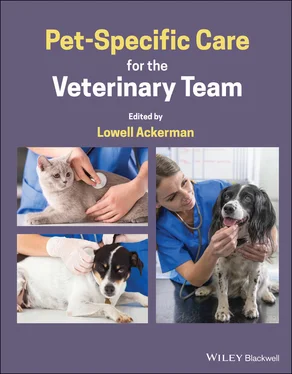Abbreviation
DNADeoxyribonucleic acid
1 Ackerman, L. (2011). The Genetic Connection: A Guide to Health Problems in Purebred Dogs, 2e. Lakewood, CO: AAHA Press.
2 Ackerman, L. (2019). An introduction to pet‐specific care. EC Vet Sci 4 (1): 1–3.
3 Ackerman, L. Personalized medicine improves outcomes. Today's Veterinary Business, 2018. https://todaysveterinarybusiness.com/personalized‐medicine‐improves‐outcomes
4 Ackerman, L. (ed.) (2020). Pet‐specific care. In: Five‐Minute Veterinary Practice Management Consult, 3e, 260–263. Ames, IA: Wiley.
5 Ackerman, L. (2020). Proactive pet parenting: Anticipating pet health problems before they happen. Problem Free Publishing.
6 American Animal Hospital Association (2012). Evolving to a Culture of Prevention: Implementing Integrated Preventive Care, 1–23. Lakewood, CO: AAHA.
7 Hamburg, M.A. and Collins, F.S. (2010). The path to personalized medicine. New England Journal of Medicine 363 (4): 301–304.
8 Harris, D.L., Rosenthal, K., and Hines, A. (2019). Thinking like a futurist could help the veterinary profession. Journal of the American Veterinary Medical Association 255 (5): 523–524.
9 Mealey, K.L., Martinez, S.E., Villarina, N.F., and Court, M.H. (2019). Personalized medicine: going to the dogs? Human Genetics 138 (5): 467–481.
10 Stull, J.W., Shelby, J.A., Bonnett, B.N. et al. Barriers and next steps to providing a spectrum of effective health care to companion animals. Journal of the American Veterinary Medical Association 253 (11): 1386–1389.
1.2 Providing a Lifetime of Care
Lowell Ackerman, DVM, DACVD, MBA, MPA, CVA, MRCVS
Global Consultant, Author, and Lecturer, MA, USA
 BASICS
BASICS
1.2.1 Summary
Much of veterinary care delivered today is based on short‐term goals, either providing care for a defined period (e.g., puppy and kitten care) or addressing issues as they present themselves, and often defaulting to treating conditions when they arise rather than trying to be proactive. In fact, it is not unusual that pet owners are seen regularly for puppy and kitten visits and then there is a drop‐off in regular care until pets become senior or otherwise develop medical issues that bring them into the veterinary hospital.
Veterinary teams would be well advised to spend time with clients, understanding their needs and concerns, explaining in advance what the likely healthcare process will be, including expenses to be anticipated along the way and when changes in healthcare requirements will likely occur. Then, the entire healthcare team should endeavor to deliver lifelong pet‐specific care on an evidence‐based schedule.
Adherence:The extent to which patients take medications as prescribed, which involves the pet owner in filling and refilling the prescription, administering the correct dose, timing and use, and completing the prescribed course.
Advocate:Someone who speaks or takes action on behalf of another.
Compliance:The extent to which pets receive a treatment, screening, or procedure in accordance with veterinary healthcare recommendations.
Continuum of Care:The timespan over which all care is provided.
Convergence Schedule:In veterinary medicine, the coming together of different processes into the same continuum of care
Genotype:The underlying genetic constitution of an individual.
Healthspan:That portion of the lifespan during which the pet remains in good general health.
Pet‐Specific Care:An approach that tailors veterinary care to individual pets based on their predicted risk of disease and likely response to intervention.
Phenotype:The outward observable characteristics of an individual, resulting from the interaction of its underlying genetic constitution with environmental factors.
Telomere:Structure at the end of a chromosome that protects DNA data. Telomere shortening is associated with aging.
 MAIN CONCEPTS
MAIN CONCEPTS
To provide care that will last a lifetime, the veterinary healthcare team needs to be able to consider the needs of the individual across that lifetime, not just at specific points in time that correspond to scheduled office visits.
It is now possible to predict the needs of pets, from the time of puppy and kitten visits well into their senior years, realizing that this is a dynamic process and the model will need to be updated and tweaked throughout the pet's life (see 6.4Creating a Pet‐Specific User's Manual).
When considering pet‐specific care across a pet's lifetime, it is also important to keep in mind that the goal is somewhat different from that of the standard model of disease treatment. In pet‐specific care, the goal is to keep the pet healthy, focusing on prevention and early detection, just as is done in human healthcare. Thus, our goal is not just to treat animals when they are sick, but to guide owners on the path to keeping their pets healthy and optimizing their pet healthspan, not just their lifespan (see 9.7Continuum of Care and Convergence Schedules). The process starts with understanding the factors that most affect health, and that begins with appreciating risk.
1.2.3 Risk (Needs) Assessment
To truly appreciate an animal's need for appropriate care, it is important to first discern which factors may impact its healthcare risks, either positively or negatively ( Figure 1.2.1). Some of these risks can be determined very early in an animal's life (some even before birth) by evaluating genotypic and phenotypic assessment of the animal, its parents, and/or close relatives.

Figure 1.2.1 Example of a canine risk assessment form.
Other assessments can be made based on local risk factors in the particular geographic area in which the animal lives. Location typically impacts the prevalence of many infectious diseases, environmental risks (snakebite, heat stroke, frostbite, toxicities, etc.), and other factors of significance. It is important not only to appreciate risks in the place of residence, but also in other environments in which the pet may find itself (e.g., travel, boarding, grooming, activities, etc.).
Assessing lifestyle information helps a practice determine the relative risks of one animal versus another in the same locale. Given a pet's risk factors from genetics, family history, and lifestyle, it is possible to discuss a lifelong customized healthcare plan that can be shared with the pet owner, so they can better anticipate the healthcare intervention that will be needed throughout a pet's life (see 2.7Risk Assessment). A personalized pet profile can then be created to customize care for animals on an individualized basis (see Figure 1.3.1).
Once owners can appreciate the veterinary care that will be needed by animals over their anticipated lifespan, they can also better plan how they are going to pay for such services. Owners can use several risk management strategies to financially prepare for such veterinary care, including pet health insurance (see 10.16Pet Health Insurance), payment plans (see 10.17Payment and Wellness Plans), and third‐party payers (see 10.18Financing Veterinary Care).
Читать дальше

 BASICS
BASICS MAIN CONCEPTS
MAIN CONCEPTS











